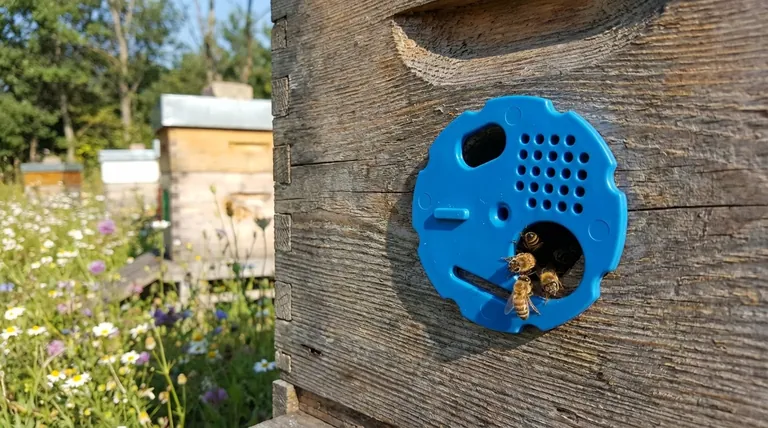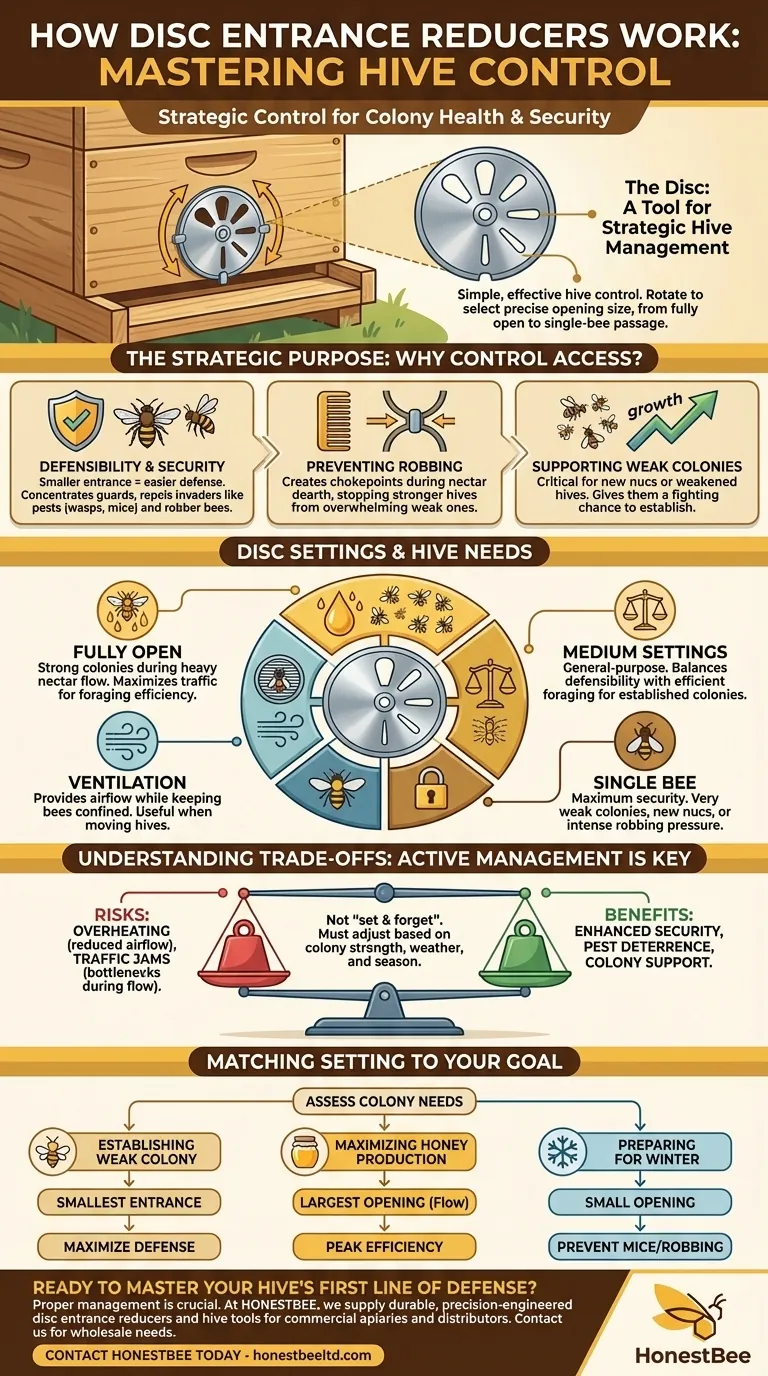At its core, a disc entrance reducer is a simple yet effective tool for hive control. It is a circular component, typically made of plastic or metal, featuring several openings of different sizes. By rotating the disc over the hive's entrance hole, a beekeeper can select the precise size of the opening, ranging from fully open to a space small enough for only one or two bees to pass through at a time.
The true function of a disc entrance reducer is not just to open or close an entrance, but to give the beekeeper strategic control over the hive's defensibility and internal environment, adapting the colony's home to its specific needs throughout the year.

The Strategic Purpose of Controlling Hive Access
A beehive’s entrance is its most vulnerable point. Managing its size is one of the most fundamental actions a beekeeper can take to ensure a colony’s health and security.
Why a Smaller Entrance is Essential
A smaller entrance is an easier entrance to defend. With fewer guard bees, a young or weak colony can be quickly overwhelmed by pests or robber bees if its entrance is too large.
By reducing the entrance, you concentrate the colony's defensive efforts on a smaller, more manageable perimeter, dramatically increasing their chances of repelling invaders.
Defending Against Robbing
During a nectar dearth—a period when natural nectar sources are scarce—stronger hives may try to steal honey from weaker ones. A reduced entrance creates a chokepoint that makes it nearly impossible for invading robber bees to overwhelm the guard bees.
Deterring Pests
Pests like wasps, yellow jackets, and mice pose a significant threat. A small opening physically prevents larger pests, particularly mice seeking warmth in the fall, from ever entering the hive.
Supporting Weak or New Colonies
A newly installed package, a nucleus hive (nuc), or a colony weakened by disease has a smaller population and fewer guard bees. Providing the smallest viable entrance is critical to giving them a fighting chance to establish themselves without being robbed of their precious resources.
How the Disc's Features Address Hive Needs
The different openings on a standard entrance disc are not arbitrary; each one serves a specific management purpose.
The "Fully Open" Setting
This setting is for strong, booming colonies during a heavy nectar flow. Maximum traffic is desirable, and the large population has more than enough guard bees to defend the wide opening.
The "Medium" Settings
These are general-purpose openings suitable for established, average-sized colonies. They offer a good balance between defensibility and allowing foragers to come and go efficiently.
The "Single Bee" Setting
This is the maximum security option. It is used for very weak colonies, new nucs, or during periods of intense robbing pressure from nearby hives. It ensures that defenders only have to face one intruder at a time.
The "Ventilation" Setting
Many discs include a setting with small holes or slats, similar to a queen excluder. This option can be used to provide ventilation while keeping the bees confined to the hive, which is useful when moving a colony.
Understanding the Trade-offs
While essential, an entrance reducer is a tool that requires active management. Using the wrong setting at the wrong time can create problems.
Risk of Overheating
A severely restricted entrance can reduce airflow. During periods of high heat and humidity, a small opening can hinder the bees' efforts to ventilate the hive, potentially leading to overheating.
Creating Traffic Jams
For a strong colony during a nectar flow, a small entrance creates a bottleneck. This "traffic jam" reduces foraging efficiency, as bees waste time and energy waiting to get in and out of the hive, ultimately impacting honey production.
The Need for Active Management
An entrance reducer is not a "set it and forget it" device. A beekeeper must assess the colony's strength, the weather, and local nectar conditions to determine the appropriate setting, adjusting it as the seasons change.
Matching the Reducer Setting to Your Goal
Your decision should always be based on the specific condition and needs of your colony.
- If your primary focus is establishing a new or weak colony: Use the smallest possible entrance to maximize its defensive capability and give it the best chance to build up.
- If your primary focus is maximizing honey production in a strong colony: Use the largest opening during a nectar flow to prevent traffic jams and support peak foraging efficiency.
- If your primary focus is preparing for winter: Reduce the entrance to a small opening to prevent robbing and keep mice out, while ensuring it doesn't become blocked by dead bees.
Properly managing your hive's entrance is a fundamental skill that directly impacts the health, security, and productivity of your colony.
Summary Table:
| Disc Setting | Primary Use Case | Key Benefit |
|---|---|---|
| Fully Open | Strong colonies, heavy nectar flow | Maximizes foraging efficiency |
| Medium | Established, average-sized colonies | Balances traffic & defensibility |
| Single Bee | Weak/new colonies, robbing pressure | Maximum security & defense |
| Ventilation | Moving hives, confined bees | Provides airflow while containing bees |
Ready to Master Your Hive's First Line of Defense?
Proper entrance management is crucial for colony health and productivity. At HONESTBEE, we supply commercial apiaries and beekeeping equipment distributors with durable, precision-engineered disc entrance reducers and other essential hive management tools through our wholesale-focused operations.
Let us help you equip your operation with the reliable supplies needed to protect your investment and maximize your success.
Contact HONESTBEE today to discuss your wholesale needs and discover how our equipment can strengthen your apiary's defense strategy.
Visual Guide

Related Products
- Multi-Functional Rotary Hive Entrance Disc for Beekeeping
- Multi-Functional Sliding Hive Entrance for Beekeeping
- Beehive Entrance Discs Plastic Bee Entrance Disc for Bee Hives
- Black Plastic Beetle Barn Hive Beetle Trap for Beehives
- Reusable Clear Small Hive Beetle Traps for Beehives Beetle Trapping Tools
People Also Ask
- What control does the circular metal beehive entrance disc provide? Master Hive Access & Bee Health
- How does the outer cover create an upper entrance? Master Hive Ventilation & Congestion Control
- What does a fully closed setting on a round beehive entrance disc indicate? A Guide to Hive Security
- What are the adjustable functions of the circular metal beehive entrance disc? Master Hive Access Control
- How does entrance configuration vary seasonally for beekeepers? A Guide to Year-Round Hive Health



















